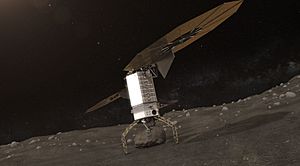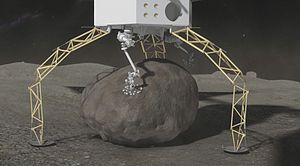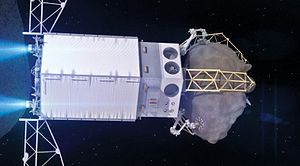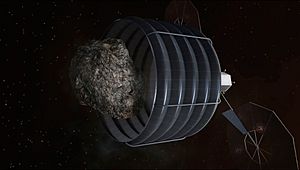Asteroid Redirect Mission facts for kids
The Asteroid Redirect Mission (ARM) was a space mission proposed by NASA in 2013. It was also known as the Asteroid Retrieval and Utilization (ARU) mission. The main idea was for a robotic spacecraft to visit a large near-Earth asteroid. It would use special robotic arms to grab a 4-meter (about 13-foot) boulder from the asteroid's surface.
The plan was for the spacecraft to study the asteroid. It would also test ways to protect Earth from asteroids. After that, it would bring the boulder to a stable orbit around the Moon. There, robots and later astronauts could study it up close. If the mission had continued, it was planned to launch in December 2021. It also aimed to test new technologies for future human trips into deep space, like advanced ion thrusters.
However, the mission was cancelled in April 2017. NASA officially ended it on June 13, 2017. Even though the mission was stopped, important technologies developed for ARM are still being worked on. This is especially true for the powerful ion thruster system.
Contents
Why the Mission Was Important
The main goal of the Asteroid Redirect Mission was to develop new ways to explore deep space. These skills were needed to prepare for a human mission to Mars and other places in our Solar System. This was part of NASA's "Journey to Mars" plan.
Getting Ready for Mars
Sending supplies to Mars can be very expensive and risky. The ARM mission aimed to test advanced solar electric propulsion (SEP) engines, also known as ion engines. These engines could help send heavy cargo to Mars much more cheaply and safely before astronauts even leave Earth.
The ARRM spacecraft itself could have been left in orbit for future use. It was designed so that parts could be refueled or replaced. This would leave a useful "space tug" near the Moon for other missions.
Exploring Deep Space Safely
Both the robotic and crewed parts of ARM would have shown that we can operate far from Earth. Yet, they would have stayed close enough for a quick return if something went wrong. A special orbit around the Moon, called Distant Retrograde Orbit (DRO), was seen as a key "stop" for missions going to or coming from deep space.
Other Important Goals
Another goal was to learn how to bring a small near-Earth asteroid into orbit around the Moon. This asteroid piece could then be studied by astronauts on a future Orion mission.
The mission also aimed to test ways to protect Earth from asteroids. This is called planetary defense. One idea was to grab an asteroid and move it directly. Another was to use a "gravity tractor" technique. This involves using the spacecraft's own gravity, made stronger by the captured boulder, to slowly pull a dangerous asteroid off its path.
The mission would also have tested advanced solar electric propulsion (ion engines) and fast laser communication in space. These new technologies are important for sending large amounts of cargo, habitats, and fuel to Mars before humans arrive.
| NASA Asteroid Redirect Mission |
|---|
|
|
How the Spacecraft Would Work
The spacecraft would have landed on a large asteroid. Robotic arms with special grippers would then grab a boulder from its surface. The grippers would dig in to get a strong hold. A drill would help anchor the boulder firmly to the spacecraft. Once the boulder was secure, the spacecraft's legs would push off the asteroid. This would give it an initial lift without needing to use its engines right away.
Powerful Engines
The spacecraft would have used advanced solar electric propulsion (SEP) for its journey. This might have been a Hall effect thruster, a type of Ion thruster. Large, efficient solar panels would provide the electricity needed (50 kilowatts).
These advanced ion engines use much less fuel than traditional chemical rockets. They can also handle more power and are more efficient. They work by trapping electrons in a magnetic field. These electrons then ionize (electrically charge) xenon gas, which is the fuel. The magnetic field also creates an electric field that speeds up these charged ions. This creates a powerful stream of plasma that pushes the spacecraft forward. The spacecraft was designed to weigh 5.5 tons without fuel and could carry up to 13 tons of xenon fuel.
Each thruster would operate at 30 to 50 kilowatts. Several thrusters could be combined to make an even more powerful SEP spacecraft. This type of engine is being developed by companies like Northrop Grumman with Sandia National Laboratories and the University of Michigan. NASA Glenn Research Center helps manage this work.
Even when a mission reaches its destination, the SEP system could provide power to keep systems running or prevent fuel from boiling away before astronauts arrive. While current SEP systems are smaller (1–5 kilowatts), a Mars cargo mission would need about 100 kilowatts. A crewed flight to Mars would need even more, around 150–300 kilowatts.
Mission Timeline
The Asteroid Redirect Mission was first planned for 2017, then 2020, and finally December 2021. However, the mission was officially cancelled in April 2017. The boulder was planned to arrive in lunar orbit by late 2025. The spacecraft could have launched on a Delta IV Heavy, SLS, or Falcon Heavy rocket.
Which Asteroid Was the Target?
As of late 2017, there were over 16,950 near-Earth asteroids known. These are found by different search teams and some are listed as potentially hazardous objects. NASA had not chosen a final target for ARM by early 2017. However, for planning and practice, they used a near-Earth asteroid called (341843) 2008 EV5 as an example. The plan was to pick up a single 4-meter (13-foot) boulder from it. Other asteroids considered were Itokawa, Bennu, and Ryugu.
The carbon-rich boulder that would have been captured (up to 6 meters or 20 feet wide, weighing 20 tons) was too small to harm Earth. It would have burned up in our atmosphere. Bringing this asteroid piece to a special orbit around the Moon would ensure it couldn't hit Earth. It would also keep it in a stable place for future studies.
History of the Idea
The idea of bringing an asteroid to Earth was discussed as early as July 1980 by NASA Administrator Robert Frosch. However, he said it wasn't possible at that time.
The ARU mission, not including any human missions, was studied in 2012 by the Keck Institute for Space Studies. The Glenn Research Center estimated the mission would cost about $2.6 billion. In 2014, $105 million was given to develop the idea further. NASA officials stressed that ARM was a step in the long-term plan for a human mission to Mars.
Two main options were studied for retrieving a small asteroid: Option A and Option B. Option A involved a large 50-foot (15-meter) capture bag. This bag could hold a small asteroid up to 8 meters (26 feet) wide and weighing up to 500 tons. Option B was chosen in March 2015. This plan involved the spacecraft landing on a large asteroid and using robotic arms to lift a boulder up to 4 meters (13 feet) wide from its surface. This boulder would then be transported and placed into lunar orbit. Option B was chosen because it was more useful for developing technologies needed for future missions. These include meeting up with objects, connecting with other spacecraft, landing, collecting samples, planetary defense, mining, and servicing spacecraft.
Some people criticized the part of the mission that involved astronauts retrieving asteroid samples from Moon orbit. They argued that thousands of meteorites have already been studied on Earth. They also said that the technology to retrieve one boulder wouldn't directly help develop a human mission to Mars. Despite these concerns, the plans were not changed. Even the NASA Advisory Council suggested in April 2015 that NASA should not do ARM. Instead, they thought NASA should focus on developing solar electric propulsion and use it for a round-trip flight to Mars.
In January 2016, NASA's Jet Propulsion Laboratory (JPL) gave contracts to companies to design a solar electric propulsion spacecraft. The robotic ARRM mission would have been the first part of ARM. Companies like Lockheed Martin Space Systems, Boeing Phantom Works, Orbital ATK, and Space Systems/Loral won these contracts.
In May 2016, the Italian Space Agency (ASI) agreed to study the mission together and possibly participate.
However, under the 2018 NASA budget proposed in March 2017, the mission was cancelled. On June 13, 2017, NASA announced that the mission was being "closed out." NASA has stated that key technologies from ARM, especially the solar electric propulsion system, will continue to be developed. This system is now planned to be used on the Lunar Gateway as the Power and Propulsion Element.
See also
 In Spanish: Misión de redirección de asteroides para niños
In Spanish: Misión de redirección de asteroides para niños





